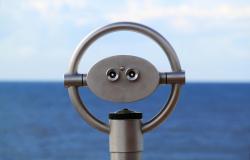Australia: East or West?

Brian Stoddart argues that Australia needs more strategic analyses of “key” partners and of the Indian Ocean as part of the Indo-Pacific.
It has been instructive traversing the Indian Ocean from Fremantle in Western Australia to Zanzibar in Tanzania via Indonesia as the “Indo-Pacific” concept escalates, and as the Australian Labour government released its defence strategic review.
The proliferation of dhow sails in Stone Town harbour, for example, was a powerful reminder that global trade and politics have been present in the Western Indian Ocean and more widely for generations. Those sails also prompted thought that the Indian Ocean is a really complex mass of cultures, polities, alignments, development stages and outlooks as well as being a rising world hotspot.
There was then the sobering thought our ship passed directly north of Diego Garcia in the British Indian Ocean Territory, the United States’ major Indo-Pacific bomber base besides Guam and one of the globe’s major intelligence gathering centres. It was also home to an Indian Ocean community, the Chagossians forcibly evicted by the British fifty years or so ago in order to establish that base. The action was eventually deemed illegal by the International Court of Justice but Britain still contests the decision.
Diego Garcia also demonstrates the enormous area that is the Indian Ocean, the island being over 4,000 kilometres from Northwest Cape in Australia, 3,500 from the Tanzanian coast and 1,700 southwest of Cape Kanyakumari in India, the other major player in this region. It is also one of the world’s busiest seaways but days pass without seeing another vessel, even if the Marine Traffic app shows a myriad of them.
Perhaps the first point to make here is the increasing focus being placed on the Indian Ocean. Over recent years, for example, France has increased its presence based on long term direct interests in La Reunion and smaller islands like Mayotte, as well as indirect interests in Mauritius and the Seychelles. Japan, too, is growing interested as something like half of its trade is reliant upon Indian Ocean access.
China and India have spurred this rising interest. With China, the push is largely reactive as two things become clear. China now is a significant world power, with an attitude shift under Xi Jinping bothering the “west” which has reacted in alarmist rather than constructive fashion. So, the new Western rush to India is driven largely by that reaction, together with a slightly more reluctant realisation that India, too, is well on the rise.
For Australia, and arguably for the United States and others, that has created contradictory positions, the most obvious being Western criticism of China’s dealings with the Muslim Uighurs going unmatched by similar criticism of Narendra Modi’s BJP government and its treatment of minorities, most notably India’s two hundred million Muslims. So we have Xi Jinping the tyrant and Narendra Modi the rock star. Then, a long term and complex relationship with Russia is overlooked in all efforts to maintain India as a full and collaborative partner in the Quad that linchpins the strategic approach to the Indo-Pacific.
Which is where Australia’s defence strategic review becomes interesting. This major document was produced over twenty eight weeks, a rapid production for such a critical statement on the nation’s future. It has six major development points that include a longer range strike capability, better capacity to operate from Australia’s northern bases, and full implementation of the AUKUS agreement that, as is now well known, effectively opens Australia to nuclear submarine visitation and capability without public debate.
The review’s significance here, though, lies with its references to the Indo-Pacific and its effective intentions there. The document contains no specification or detail on what constitutes the “Indo-Pacific” but includes a broad map that stretches to Africa. There is, however, a specification (p8) that focus is on Southeast Asia and the Pacific, and (p28) the “Northeast Indian Ocean” and across to the Pacific. That is buttressed by a clear indication that the United States is the most important ally in this enterprise, and China the main protagonist, but there is reference to improving relations with “key” Indo-Pacific partners.
Public commentary in India is pleased the country is identified, along with Japan, as one of those key partners, but what New Delhi really thinks might take a while to emerge. After all, as members of the Quad, India and Japan could scarcely not be “key” partners, but the specific geographical focus mentioned in the review must give them pause for thought.
It might also give the rest of that vast Indian littoral the same pause, and that should include Western Australia, a third of the nation’s land mass as well as its major wealth driver, thanks to iron ore and other minerals gone to China and the world for the past fifty years or so. Incidentally, there are almost seven hundred Australian mining interests in Africa with a total investment of $A40 billion. That is a major imprint on a continent where China has been extending its interests, in minerals and elsewhere, for over thirty years.
By definition, then, Western Australia is the country’s major connection with the Indian Ocean proper, so it might have been thought that would have been recognised in the defence report. But no, at least to the extent that might well have been given, for example, the Harold Holt centre at Exmouth, long a major link in the global intelligence gathering system that includes Diego Garcia as a central node.
Western Australia has long argued in Canberra it should have far more of a defence outlook into the Indian Ocean, a view sharpened by the AUKUS announcement that American nuclear submarines will soon visit Western Australia on rotation. Western Australia’s government had already committed to more investment in defence industries on the back of a failed attempt to have work on the present Collins class submarines done in the West. The defence strategic review, however, in line with that specific geographic focus, commits to a new nuclear submarine base somewhere on the east coast that will be the subject of all the normal interstate rivalry and bidding.
As an aside, there is a growing scepticism about the merits or otherwise of this new AUKUS submarine deal, and sceptics include former naval personnel from around the world with whom I have spoken.
There is a further curious aspect to the evolution of this review and its geographical limits. It was produced by former Chief of the Defence Force, Angus Houston, in association with Stephen Smith, former Labour Defence and Foreign Affairs Minister who is from Perth where he was Chair of the curiously named Perth USAsia Centre based at the University of Western Australia. Smith is now High Commissioner to London. Peter Dean, who did much of the review work, ran a defence and security program in collaboration with that Centre and is now at the United States Studies Centre at the University of Sydney.
The focus here on the USA is clear, and raises real questions about just how much of a focus there is on the Indian Ocean as part of the Indo-Pacific. It also goes to the lack of independent strategic analysis about Australia’s regional and global position. While strong Indian Ocean research centres have developed at universities like McGill in Canada and Leiden in the Netherlands, for example, earlier strengths in Australia and especially Perth have diminished. Government commitment to defence spending is understandable, but similar investment in knowledge research concerning all those “key” strategic partners should also be a priority.
That would in part, at least, help break the stranglehold on public opinion about China, in particular, held by more captured agencies like the Australian Strategic Policy Institute in Canberra, partially funded by the defence industry. There is much to be criticised in China, certainly, but there is also much that needs to be better researched and understood in Australia if the combative pseudo aggressive stance that effectively underlies the strategic defence review and our evolving foreign policy is to be broken.
Australia has changed governments recently, but not a world view that derives from Washington at the expense of all those cultures and polities that line the littoral of the Indian ocean.
Brian Stoddart is Emeritus Professor at La Trobe University in Melbourne, Australia where he served as Vice-Chancellor, a higher education consultant internationally, a regular commentator on global issues, cruise ship lecturer, and a crime fiction writer.
Photo by Pixabay


